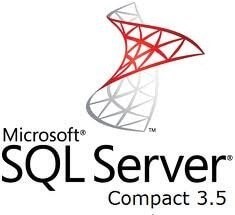

- #DO I NEED MICROSOFT SQL SERVER COMPACT 3.5 SP2 X64 ENU HOW TO#
- #DO I NEED MICROSOFT SQL SERVER COMPACT 3.5 SP2 X64 ENU SOFTWARE#
- #DO I NEED MICROSOFT SQL SERVER COMPACT 3.5 SP2 X64 ENU OFFLINE#
- #DO I NEED MICROSOFT SQL SERVER COMPACT 3.5 SP2 X64 ENU WINDOWS#
Microsoft Sync Framework 2.1 Software Development Kit (SDK) - SyncSDK-v2.1-圆4-ENU.msi or. Installing SDK’s and Frameworksīefore we begin development we need to have the following SDK’s and Frameworks installed if they are missing: We will be using Visual Studio 2012 and MS SQL 2012 for building this application. On the server side we will use WCF web services, MS SQL 2012 (you can use MS SQL 2008/Express does not matter) and MS Sync Framework v2.1. To summarize technologies used, on client side we will use WPF, SQL CE 3.5 Sp2 and MS Sync Framework v2.1. The default WCF sample provided by Microsoft is built under the assumption that the WCF service will be self-deployed, while we have modified the sample to deploy the service in IIS. In this blog post we are building upon the sample provided by Microsoft but making things clear to understand.
#DO I NEED MICROSOFT SQL SERVER COMPACT 3.5 SP2 X64 ENU HOW TO#
The core reason behind this blog post is that the sample presented by Microsoft is not well documented nor is it clear how to deploy the sample application. On the server side, we will expose the sync framework using WCF (Windows Communication Framework) web services.

Tooling support in Visual Studio 2012 is built to support SQL CE 4.0 and does not work with SQL CE 3.5. For reasons best known to Microsoft they have chosen to release SQL CE 4.0 without support for synchronization, so we are stuck to using SQL CE 3.5 SP2. The other major issue with using Sync Framework 2.1 is that it depends upon SQL CE 3.5 SP2 and does NOT work with the latest SQL CE 4.0. The only highlight for this framework is that Microsoft is promoting it as the means to synchronize with Azure cloud databases, so there are some updated samples provided. If you want to use Sync Framework 4 then you need to manually handle the client side sync code. The latest, Sync Framework 4 builds upon Sync Framework 2.1 and provides OData based synchronization so that you can synchronize between device platforms without installing any framework on the client platform, but it does not provide any features for automatic sync between client and server db. We are stuck to using Sync Framework v2.1, released in last quarter of 2010 for our solution since we wish to have a framework that provides automatic synchronization between SQL CE and SQL Server databases. The state of technologies that allow synchronization between client and server is bad and totally confusing! The sync framework has not advanced in ages, while there is no alternative path presented.
#DO I NEED MICROSOFT SQL SERVER COMPACT 3.5 SP2 X64 ENU WINDOWS#
The choice of technology for building Windows based application is WPF (Windows Presentation Framework), but the pace of development on WPF is certainly way behind the pace of development on the web technologies side. Over the years there has been a much greater push of new technologies built for the web and mobile devices, but there seems to be much slower pace of development on the Windows application development side from Microsoft. The best solution for this business problem was to create Windows based applications which would sync data with a central server hosted on the internet. There are significantly large number of businesses in developing countries like India who still don’t have access to reliable Internet connections, we have no choice but to build Windows desktop based applications for them. Internet connection could not be guaranteed at all times so creating a web/mobile based application was ruled out.

The particular client that we were working for had employees who used to travel extensively and needed data at least refreshed daily. This blog post does not try to explain in detail how sync framework works, but tries to explain the creation of WCF based web service to sync between server and clients over the internet.

In this post we have tried to build upon the samples provided by Microsoft but explain the whole process so that its easier for others to understand and implement this platform. We faced several challenges in building this application and I thought it would be a good idea to blog the solution we created for the client.
#DO I NEED MICROSOFT SQL SERVER COMPACT 3.5 SP2 X64 ENU OFFLINE#
Recently, we were working on a client project where the client required multiple line of business Windows Based Client Applications to be able to work offline and synchronize with the master MS SQL Database (hosted on the internet), when internet connection is available. NET, SQL CE 3.5 SP2, SQL Server, Sync, Sync Framework v2.1, WCF, WPF


 0 kommentar(er)
0 kommentar(er)
